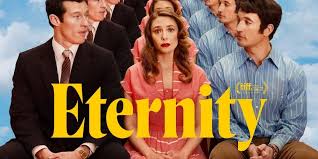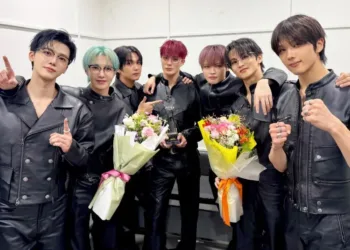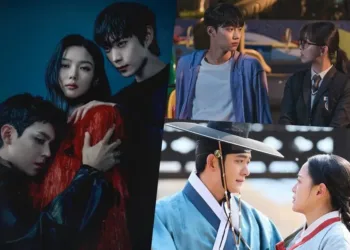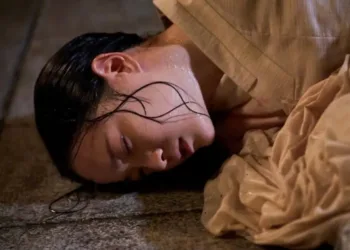A24’s latest romantic comedy Eternity poses an impossible question: When faced with eternity, do you choose the love that burned brightest or the love that lasted longest? Elizabeth Olsen stars as Joan, a woman who must decide between two husbands in the afterlife—Luke, her first love lost to war, or Larry, the man she built a lifetime with. Here’s everything you need to know about Joan’s final decision and what it means for the concept of eternal love.
Table of Contents
Love Beyond Death: Eternity Movie Quick Guide
| Detail | Information |
|---|---|
| Release Date | November 26, 2025 (Theaters) |
| Director | David Freyne |
| Studio | A24 |
| Genre | Romantic Comedy/Fantasy |
| Stars | Elizabeth Olsen, Miles Teller, Callum Turner |
| Runtime | Approximately 106 minutes |
| Rating | Not yet rated |
The Impossible Love Triangle
Joan’s dilemma begins when she dies shortly after her husband Larry and arrives at “The Junction”—a stylized afterlife waystation where souls have one week to choose their eternal destination. She’s shocked to discover that Luke, her first husband who died in the Korean War 67 years earlier, has been waiting for her all this time, working as a bartender rather than moving forward.
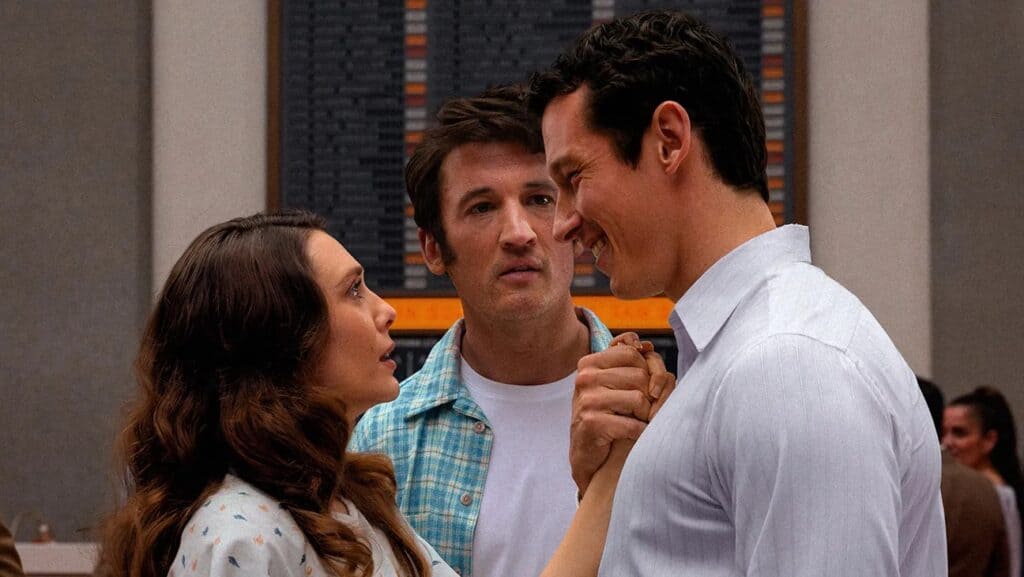
Larry represents comfort and companionship built over decades. They raised children together, argued about small things, and grew old side by side. Luke embodies passionate young love frozen in time—romance that never had the chance to become complicated or mundane.
The film frames both men sympathetically. Luke waited decades for Joan, believing their connection transcended death itself. Larry created a full life with her, weathering challenges and celebrating victories together. Neither choice feels wrong, which makes the decision agonizing.
Who Does Joan Choose? (Spoiler Alert!)
Joan ultimately chooses Larry after initially selecting Luke. She first decides to spend eternity with Luke in his mountain paradise cabin, but quickly realizes she made a mistake. The youthful romance she remembers doesn’t match the reality of who they became—or rather, who they never got to become together.
Joan breaks afterlife rules by leaving Luke’s eternity and tracking down Larry, who had declined to choose his own eternal destination. Instead, Larry took over Luke’s bartending position at The Junction, essentially waiting for Joan just as Luke had done. When Joan finds him and asks him to run away with her, Larry doesn’t hesitate.
The couple settles in a simple suburban eternity that resembles Oakdale, the town where they raised their family. For strategies on understanding complex relationship narratives in film, explore our entertainment analysis guides.
Why Joan’s Choice Matters
Director David Freyne explained that Joan’s decision represents lived love over imagined perfection. Luke and Joan never experienced the ordinary challenges that define real relationships—disagreements, compromises, daily frustrations, and deeper understanding that comes from growing together.
Their romance remained preserved in amber, beautiful but static. Luke represents what could have been, while Larry represents what actually was. Joan realizes that decades of shared experiences, including the difficult moments, created bonds stronger than nostalgic passion.
The film suggests that enduring love isn’t about constant excitement or perfect harmony. It’s about choosing someone repeatedly through routine and change. Joan chose Larry thousands of times during their marriage, and she chooses him again in death.
The Deeper Meaning
Eternity explores modern anxiety about endless choices. As Olsen noted in interviews, we’re constantly told something better exists—better products, better experiences, better lives. This creates paralysis and dissatisfaction even when we have good things.
Joan’s journey reflects this cultural moment. She had genuine happiness with Larry but wondered about the path not taken with Luke. The afterlife forces her to confront whether chasing alternative possibilities brings fulfillment or just endless uncertainty.
The film’s message resonates: commitment isn’t about finding someone perfect but about building something real with an imperfect person. For more thought-provoking film analysis and reviews, discover our entertainment coverage.
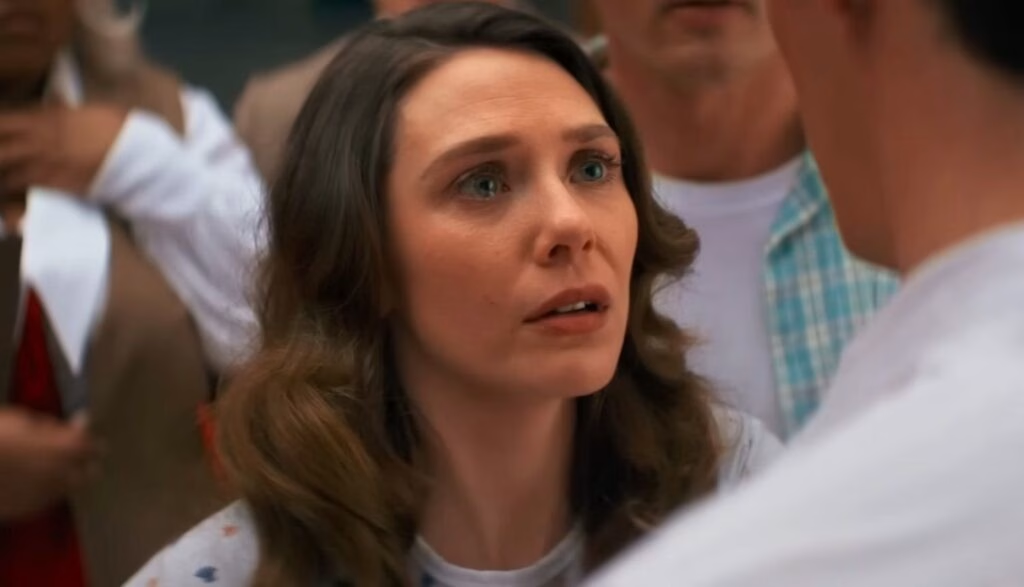
Critical Reception and Themes
Reviews have been mixed, with praise for the cast performances and imaginative afterlife setting, but some critics found the central romance underdeveloped. The film works best when exploring how memory idealizes the past and how true intimacy develops through shared imperfection.
Da’Vine Joy Randolph and John Early provide comic relief as afterlife coordinators, while the production design creates a vibrant mid-century modern aesthetic for The Junction. The Archives—where couples can revisit their memories as life-sized dioramas—provides the film’s most visually striking sequences.
For updates on new releases and where to watch, visit A24’s official website for theatrical information and future streaming details.
The Perfect Ending
The film closes with Joan and Larry walking through their chosen suburban eternity, arm in arm. When Larry observes it looks like Oakdale, Joan replies simply: “It’s perfect.” This understated conclusion emphasizes that perfection isn’t exotic destinations or grand gestures—it’s the familiar comfort of being with someone who truly knows you.
Their choice to recreate ordinary life rather than select paradise speaks volumes. They don’t need perfection because they found completeness in each other through years of real experience, not idealized fantasy.
Stay updated on the latest film releases and entertainment news at TechnoSports, where we cover everything from blockbusters to indie gems!
Frequently Asked Questions
Q: Does the movie have a post-credits scene?
A: No, Eternity does not include any post-credits scenes. The film ends with Joan and Larry settling into their chosen suburban eternity, providing a complete emotional conclusion without additional footage. Director David Freyne intentionally crafted a definitive ending that doesn’t require extra scenes to clarify the story or set up potential sequels. The final image of the couple walking together serves as the movie’s last statement on enduring love.
Q: What happens to Luke after Joan chooses Larry?
A: The film shows Luke helping Joan escape from their chosen eternity once he realizes she’s unhappy, demonstrating his genuine love for her means wanting her happiness above his own desires. While the movie doesn’t explicitly show Luke’s fate afterward, he’s portrayed accepting Joan’s decision with grace and understanding. Luke recognizes that his 67-year wait was based on a memory of young love rather than the reality of who Joan became over her lifetime. His character arc concludes with him releasing Joan, allowing her to find true happiness even if it’s not with him.

